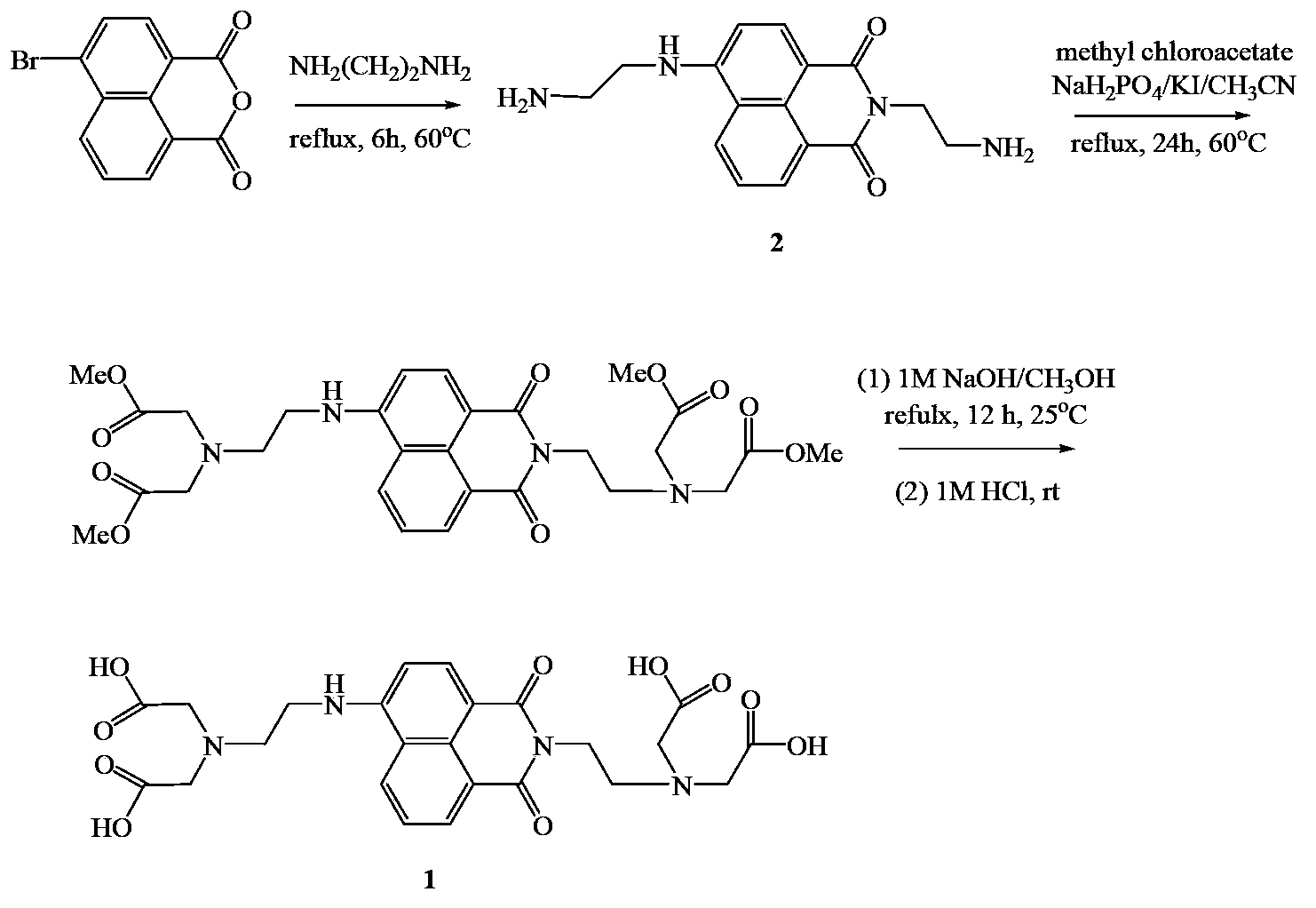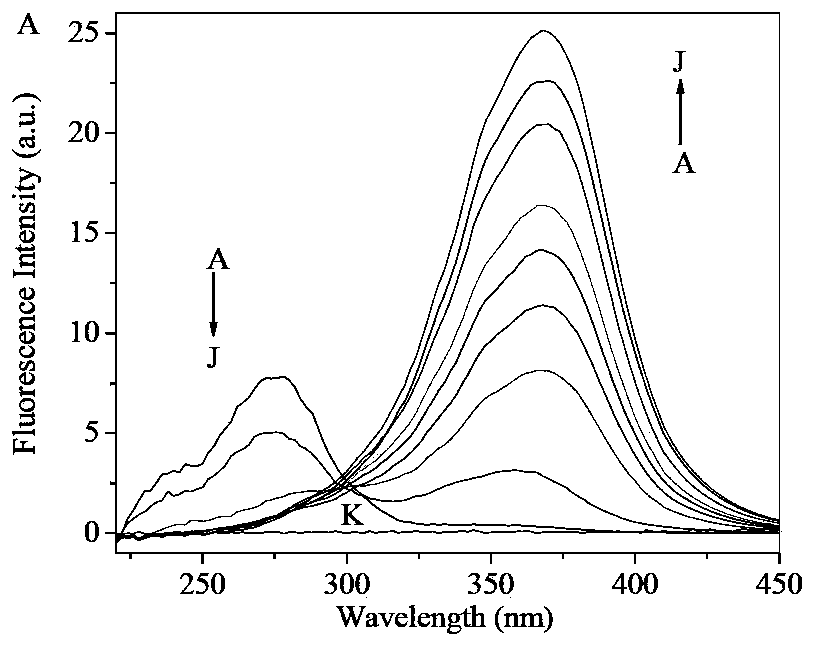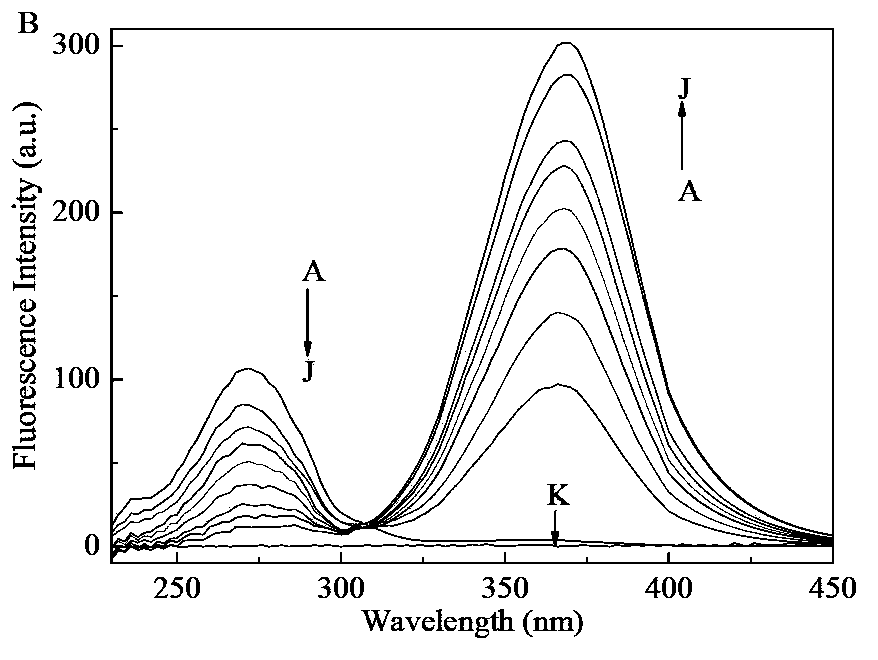Preparation method of 1,8-naphthalimide derivative fluorescent probe and method for detecting casein by using biological probe
A technology of fluorescent probe and naphthalimide, which is applied in the direction of fluorescence/phosphorescence, chemical instruments and methods, luminescent materials, etc., can solve the problems of expensive detection instruments, complicated operation process, poor sensitivity and selectivity, etc., and achieve a good choice performance, high sensitivity, and improved sensitivity
- Summary
- Abstract
- Description
- Claims
- Application Information
AI Technical Summary
Problems solved by technology
Method used
Image
Examples
Embodiment 1
[0025] Add 2.77g, 10.0mmol / L 4-bromo-1,8 naphthalene anhydride and 100mL ethylenediamine into a round bottom flask, heat and stir at 60°C for 6 hours, then cool, and vacuum dry to remove ethylenediamine to obtain an intermediate product. Dissolve the intermediate product and 11.9mL, 140mmol / L methyl chloroacetate in 15mL acetonitrile, add NaH 2 PO 4 , 0.5g each of KI, heated and stirred at 40°C for 3 days, the solution was clear, added 0.25mL, 3mol / L NaOH was added and continued to stir for 12 hours, after cooling, the pH value of the system was adjusted to 2-3 with 1M HCl, anhydrous Ethanol recrystallized twice to obtain a yellow solid probe.
[0026] Yield: (79%).IR(cm -1 ):3376(vNH);2830(νCH);1732(νC=O);1693(ν as Naphthalimide N-C=O); 1656(ν a Naphthalimide N-C=O). 1 H NMR (400MHz, CDCl 3 )δ:8.03-7.92(d,J=8.4Hz,3H),7.56(t,J=7.8Hz,1H),6.66(d,J=7.1Hz,1H),5.83(t,J=7.3Hz, 1H),4.9(m,1H),4.05(s,4H),3.75-3.86(t,J=9.2Hz,4H),3.17(s,8H),2.66-2.70(t,J=8.0Hz,4H ).Elemental Anal...
Embodiment 2
[0028] Add 2.77g, 10.0mmol / L 4-bromo-1,8 naphthalene anhydride and 100mL ethylenediamine into a round bottom flask, heat and stir at 70°C for 4 hours, then cool, and vacuum dry to remove ethylenediamine to obtain an intermediate product. Dissolve the intermediate product and 11.9mL, 140mmol / L methyl chloroacetate in 15mL methanol, add NaH 2 PO 4 , 0.5 g each of KI, heated and stirred at 45°C for 2 days, and the solution was clarified. Add 0.25 mL, add 3mol / L NaOH and continue to stir for 10 hours. After cooling, adjust the pH value of the system to 2 with 1M HCl. Crystallization three times gave a yellow solid probe.
[0029] Yield: (79%).IR(cm -1 ):3376(vNH);2830(νCH);1732(νC=O);1693(ν as Naphthalimide N-C=O); 1656(ν a Naphthalimide N-C=O). 1 H NMR (400MHz, CDCl 3 )δ:8.03-7.92(d,J=8.4Hz,3H),7.56(t,J=7.8Hz,1H),6.66(d,J=7.1Hz,1H),5.83(t,J=7.3Hz, 1H),4.9(m,1H),4.05(s,4H),3.75-3.86(t,J=9.2Hz,4H),3.17(s,8H),2.66-2.70(t,J=8.0Hz,4H ).Elemental Analysis: Calculation: C 24 h ...
Embodiment 3
[0031] Dissolve 500 mg of casein in 100 mL of PBS (pH 7.4) buffer solution to obtain a 5 mg / mL casein solution, and dissolve 0.5 μmol of fluorescent probe in 100 mL of PBS (pH 7.4) buffer solution to obtain a 5 μmol / L fluorescence probe Probe solution.
[0032] Dissolve 500 mg of casein in 50 mL of PBS (pH 7.4) buffer solution to prepare a 10 mg / mL casein solution, add 4 drops of 0.1 mol / L NaOH solution and sonicate for 1 min until the solid dissolves, then add 0.1 M HCl to adjust the pH to 7.4. Dissolve 0.5 μmol fluorescent probe mol / L in 100 mL PBS (pH 7.4) buffer solution to prepare 5 μmol / L fluorescent probe mol / L solution.
PUM
 Login to View More
Login to View More Abstract
Description
Claims
Application Information
 Login to View More
Login to View More - R&D
- Intellectual Property
- Life Sciences
- Materials
- Tech Scout
- Unparalleled Data Quality
- Higher Quality Content
- 60% Fewer Hallucinations
Browse by: Latest US Patents, China's latest patents, Technical Efficacy Thesaurus, Application Domain, Technology Topic, Popular Technical Reports.
© 2025 PatSnap. All rights reserved.Legal|Privacy policy|Modern Slavery Act Transparency Statement|Sitemap|About US| Contact US: help@patsnap.com



